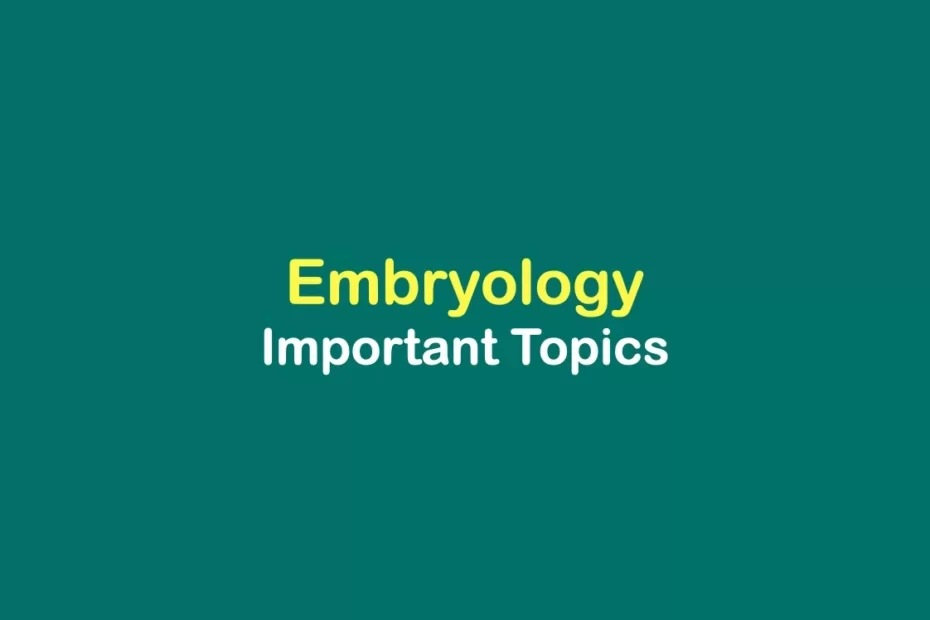This post holds some important questions topics from Embryology. We have discussed about the Tounge, Palate, Kidney, Heart Septum, Stomach and Aorta.
Here In this post we are going to discuss about the all important topics of Embryology.
- Genetics and Molecular Biology
- Development of Tongue and Nerve supply
- Development of Soft Palate
- Development of Kidney
- Development of Interventricular Septum with blood supply
- Development of Interatrial Septum with blood supply
- Development of Stomach
Meaning/ Definition :
This is the study of the development of gametes and then the fertilisation and the formation of embryos and foetuses.
What are the important topics :
1. Genetics and Molecular Biology in Embryology
We study about the Genes, DNA structure, Chromosomes, Karyotyping, Sex chromatin, Pedigree chart, Cell Division
- Genes : These are the basic physical and functional unit of heredity. Genes are made up of DNA.
- DNA Structure : Deoxyribonucleic Acid, has two strands which are linked to each other at regular intervals.
- Chromosomes : There are 36 chromosomes, in which 44 are autosome and 2 are sex chromosome. The sex chromosome may be of two kinds, X or Y.
- Karyotyping : The procedure by which mapping of the chromosome can be done.
- Sex Chromatin : These are condensed mass of X-chromosome within the nucleus of individual cell.
- Pedigree Chart : These are representation of a particular chromosomal disorder of generation of a family.
2. Development of Tongue and Nerve Supply
The tongue develops in pattern by the pharyngeal arches(1st-4th), in the floor of the developing mouth.
- Lingual Swellings : The medial most part of the mandibular arches proliferate to form two lingual swellings.
- Thyroglossal duct : The epithelium behind the tuberculum proliferate to form Thyroglossal duct.
- –> From Thyroglossal Duct the Thyroid Gland develops.
- Hypobranchial eminence : The midline swelling is seen in relation to the medial ends of the second, third and fourth arches.
A. Formation of Anterior 2/3rd of the Tongue : This is formed by the fusion of the tuberculum impair and the two lingual swellings.
B. Formation of posterior 1/3rd : This is formed from the cranial part of the hypobranchial eminence.
C. The posterior most part : This is derived from the fourth arch.
Nerve Supply :
- Anterior 2/3rd : Lingual branch of mandibular nerve and by the chords tympani nerve.
- Posterior 1/3rd : By Glossopharyngeal nerve.
3. Development of Soft Palate
From each maxillary process a palate like shelf grows towards medial side, called the palatal process of maxilla.
- Primary Palate : Formed by the fusion of two medial nasal processes of front-nasal process.
- Secondary Palate : Tongue develops in the floor of the oral cavity.
- Definitive/Permanent Palate : Formed by the fusion of Palatal processes of maxilla with primitive palate Both palatal processes of maxilla, Palatal processes with nasal septum.
4. Development of Kidney
- The Secretory part or Excretory tubules are derived from the lowest part of the nephrogenic cord.
- The Collecting part of the kidney is derived from a diverticulum called ureteric bud.
5. Development of Interventricular Septum with blood supply
The inter ventricular septum consists three parts which develops from different sources:
- Muscular Part : A septum, called the inter ventricular septum, grows upward from the floor of the bulboventricular cavity.
- Bulbar Part : The right and left bulbar ridges, arise in the wall of the bulboventricular cavity.
- Membranous Part : The gap between the upper edge of the interventricular septum, and the lower edge of bulbar septum, is filled by the proliferation of tissue derived from the right of the AV cushions.
6. Development of Interatrial septum with blood supply
The atrial chamber undergoes division into right and left halves by formation of two septa.
- Appearance of septum Primum
- Appearance of Septum Secondum
7. Development of Stomach
Development fo the stomach occurs from the foregut, and has a dorsal and ventral mesogastrium.
—The dorsal mesogastrium gives rise to the greater omentum.
–More rapid growth of the dorsal portion occurs, then the stomach expands, which leads to greater and lesser curvature formation.
–Then it undergoes two rotations :
- 90° about the long axis and Anti-clockwise around the doors-ventral axis.
